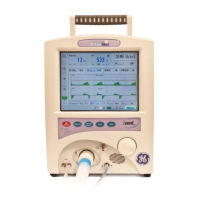5 Adaptive Bi-Level
137
EASY EXHALE
Easy Exhale is an advanced feature of the iVent
TM
201, minimizing the imposed
exhalation valve resistance when PEEP > 0 is selected. By minimizing the
exhalation valve resistance, we ensure as short exhalation time as possible thus
reducing the risk of auto-PEEP.
Easy Exhale works by fully opening the exhalation valve at the early stages of
exhalation, allowing the patient to exhale faster, compensating for the system
and patient resistance. After this initial fully open position, the valve re-inflates to
the set PEEP pressure in order to maintain the set PEEP in the patient’s lungs. The
duration of Easy Exhale is determined by the measured time constant of the lung,
ensuring that the pressure inside the lung never falls below the set PEEP, even
though the pressure at the airway might do so for a short time.
NOTE The default setting for Easy Exhale in Adaptive Bi-Level mode is On. This
default can be disabled through the Advanced Settings screen at the
operator’s discretion (See page 93).
OPTIMIZING THE PATIENT VENTILATOR INTERFACE
Setting up the Patient Ventilator interface is straightforward. Either a nasal CPAP
mask or a full-facemask can be used. If the mask incorporates an anti-asphyxia
device, make sure that it closes on pressurizing the mask and does not require
continuous uni-directional flow to remain closed.
Connect the facemask to the circuit using an OmniFlex or a double swivel elbow
to increase circuit flexibility. Connect the circuit directly, without the use of an
HME filter or a bacterial filter, between the flow sensor and the facemask. Finally,
ensure that the sensor lines are not kinked or disconnected.
RESOLVING PATIENT VENTILATOR DYSYNCHRONY
EXCESSIVE VENTILATION
If there is excessive ventilation reduce either the respiratory rate or the IPAP level.
EXCESSIVE LEAK
Detection - Excessive leak is confirmed by visually examining the mask interface
about the patient's face.
Intervention - Ensure that an approved and suitably sized nasal mask or
facemask is being used (see manufacturer’s instructions). Adjust the headgear
and ensure that there is equal tension among all of the straps. If necessary, apply
padding across the nasal bridge and chin.

